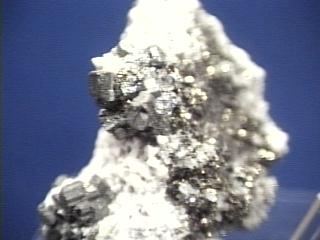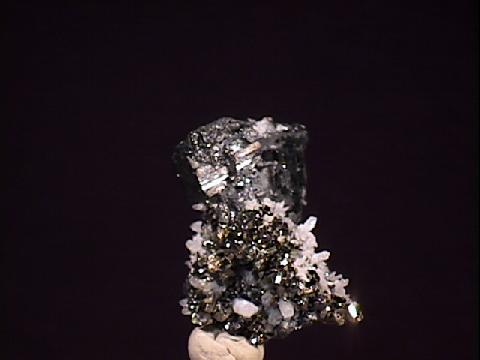
BOURNONITE
Specimen bou-7
$ 90.00
Dims: 0.89x0.88x0.88" (2.27x2.24x2.23cm)
Wt: p.94oz (26.6g)
Mercedes Mine, Huanuco, Peru
This is essentially a large single crystal of bournonite, the "cog wheel ore". It does display the deep striations which (when combined with twinning) results in the cog-wheel shape. This specimen has a lead-gray color and a somewhat unusual luster: it is both highly lustrous and deeply pitted, which gives it an unusual texture. Most of the crystals are doubly-terminated, although these are generally obscured or distorted. There are a lot of tiny quartz crystals at one end, and a loupe reveals that there are bits of the original dull gray host rock still lingering in the crevices - it looks like the mineral was dissolved with acid. This specimen was part of an old collection.

 Amethyst Galleries' Mineral Gallery MINERALS |

BOURNONITE specimen bou-1
$ 65.00
$ 65.00
Dims: 2-1/2" x 2" x 1"
Wt: 7.9 oz
Pachapaqui Mine, Ancash, Peru
This potpourri of metal sulfide minerals includes Bournonite, a rather rare lead, copper, and antimony sulfide, along with Sphalerite, Pyrite, Quartz, and Mangano-Calcite, a calcium and manganese carbonate mineral. They occur in clusters up to 1/2 inch long and in pseudo-cubic crystals about 1/8 inch in diameter. The crystals are of very good quality, if a little small, and the specimen was separated from the host rock in such a way as to leave a good, flat base for steady display without a stand.

bou-1 ($ 65.00)
Pachapaqui Mine, Ancash, Peru

BOURNONITE specimen bou-2
$ 125.00
$ 125.00
Dims: 4-1/2" x 3" x 2"
Wt: 17.1 oz
Pachapaqui Mine, Ancash, Peru
The Bournonite that is littered all over this specimen are of reasonably good quality, with clusters of 1/4 inch crystals that approach the "cog-wheel" formation without actually getting there. Pyrite, Quartz, and Mangano-Calcite, a calcium and manganese carbonate mineral all accompany to set up a very tasteful mineralogical quartet.

bou-2 ($125.00)
Pachapaqui Mine, Ancash, Peru

BOURNONITE specimen bou-3
$ 97.00
$ 97.00
Dims: 4-1/2" x 3-3/4" x 1-1/2"
Wt: 1 lb., 4 oz
Pachapaqui Mine, Ancash, Peru
This specimen has a very large amount of this uncommon metal sulfide in excellent crystal form. Some "cogwheel" formations are visible, and there is a lot of penetration twinning. The crystals are up to 1/2 inch in width, with the majority of them ranging from 1/8 to 1/4 inch. Around the Bournonite crystals are tiny, imperfectly-formed Quartz crystals, and the matrix rock is a hodgepodge of massive Sphalerite, Galena, and Pyrite. It is one of the more concentrated Bournonite specimens I've seen.


bou-3 ($ 97.00)
Pachapaqui Mine, Ancash, Peru

BOURNONITE specimen bou-4
$ 60.00
$ 60.00
Dims: 1.1 x 0.8 x 0.8" (2.7 x 2.1 x 2.0 cm)
Wt: 16 g
Pachapaqui Mine, Ancash Department, Peru
A cluster of several twinned Bournonite prisms extends from the small base of this thumbnail specimen. The Bournonites are in excellent condition and reach dimensions of 0.5 x 0.3 x 0.3" (1.4 x 0.8 x 0.7 cm). All have very good orthorhombic prismatic form, and one has repeated twinning to form a portion of a trilling. All have the dark silvery-gray color and dull metallic luster that are characteristic of this specie. The small base on which they rest is made up of many tiny, intergrown quartz and pyrite crystals, and more Bournonite.


bou-4 ($ 60.00)
Pachapaqui Mine, Ancash Department, Peru

BOURNONITE specimen bou-5
$ 44.00
$ 44.00
Dims: 2.9x1.5x0.9" (7.3x3.9x2.4 cm)
Wt: 4.45 oz. (126g)
Quiruvilca, La Libertad, Peru
On a pyrite & quartz base rests a thick (10-12mm) crust of bournonite, the surface of which displays dozens of crystals. Although they are relatively flat (none rises more than 3 or 4mm above the massive bournonite crust), they have a variety of orientations, showing various faces and terminations. Many show lengthwise striations, although I did not see any "cog wheel twins".

bou-5 ($ 44.00)
Quiruvilca, La Libertad, Peru

BOURNONITE specimen bou-6
$ 45.00
$ 45.00
Dims: 3.26x2.84x2.38" (8.28x7.21x6.04cm)
Wt: 14.56oz (412g)
Kapnik, Romania
This hand specimen is a dense cluter of tiny clear quartz crystals, largely covered with a variety of sulfides. The largest crystals are sphalerite crystals which appear black except at fracture areas where the translucent and yellow color of the spalerite is apparent. The majority of the crystals are of bournonite, with a complex shape and curved patterns of striations. Under a loupe, these are quite appealing, and they have a silver color with a slight tarnish. There are a few larger crystals of chalcopyrite, too, with a golden color and slightly irridescent finish. There are tiny crystals of galena visible, too, recognizable by their silver color, bright luster, and cubic growth patterns.

bou-6 ($ 45.00)
Kapnik, Romania

BOURNONITE specimen bou-7
$ 90.00
$ 90.00
Dims: 0.89x0.88x0.88" (2.27x2.24x2.23cm)
Wt: p.94oz (26.6g)
Mercedes Mine, Huanuco, Peru
This is essentially a large single crystal of bournonite, the "cog wheel ore". It does display the deep striations which (when combined with twinning) results in the cog-wheel shape. This specimen has a lead-gray color and a somewhat unusual luster: it is both highly lustrous and deeply pitted, which gives it an unusual texture. Most of the crystals are doubly-terminated, although these are generally obscured or distorted. There are a lot of tiny quartz crystals at one end, and a loupe reveals that there are bits of the original dull gray host rock still lingering in the crevices - it looks like the mineral was dissolved with acid. This specimen was part of an old collection.


bou-7 ($ 90.00)
Mercedes Mine, Huanuco, Peru

BOURNONITE specimen bou-8
$ 60.00
$ 60.00
Dims: 2.73x1.74x1.42" (6.93x4.43x3.61cm)
Wt: 6.41oz (181.7g)
Nica, Chihuahua, Mexico
This specimen is primarily composed of bournotite with all of the surface crystals showing excellent (but not twinned) crystallization. The bournonite is black and opaque, with a vitreous luster. The crystals display a hex-octagonal form - all of the faces are triangles. Some faces show stepped growth patterns, and only a few show strong striations. The lack of twinning means that I cannot see any "cog wheel" crystals. The bournonite is accompanied by tiny quartz crystals, some doubly terminated, and by very nice arsenopyrite crystals which a loupe resolves as golden prismatic crystals with a diamond cross section and a slanted termination. There is also a small amount of albite present with good crystal form.


bou-8 ($ 60.00)
Nica, Chihuahua, Mexico

BOURNONITE specimen bou-9
$ 40.00
$ 40.00
Dims: 1.90x1.14x0.73" (4.84x2.90x1.84cm)
Wt: 2.15oz (60.9g)
Naica, Chihuahua, Mexico
This specimen displays quite a bit of bournonite, on a base of mostly galena. The bornonite is easily recognized as it has characteristic deep striations and a "cog-wheel" appearance. There are other minerals present, of course, including quartz and dolomite. I suspect that there once was a lot of calcite which has been disolved away. I deduce this because there are some amorphous metallic areas with a very bright luster. I think that is galena whose shape was constrained by the enclosing calcite. There is also other sulfides present, including at least pyrite, but likely others as well.


bou-9 ($ 40.00)
Naica, Chihuahua, Mexico

BOURNONITE specimen bou-10
$ 30.00
$ 30.00
dims mm=75.6x66.3x36.8
wt g=267
Nica, Chihuahua, Mexico
This specimen is a hodgepodge of minerals, all likely sulfides, carbonates or sulfates. One side of the specimen is dominated by shiny galena and relatively large colorless calcite scalenohedrons. The other side is mostly black cogwheel shaped bournonite crystlas overgrown with a variety of minerals including calcite, something white and opaque that I don't recognize, and large thin tabulr transparent crystals that look like barite or celestite (but could even be anhydrite). There are also a variety of sulfides present. In addition to the obvious bournonite and galena, there are patches of chalcopyrite and some tiny blades that look like stibnite.


bou-10 ($ 30.00)
Nica, Chihuahua, Mexico